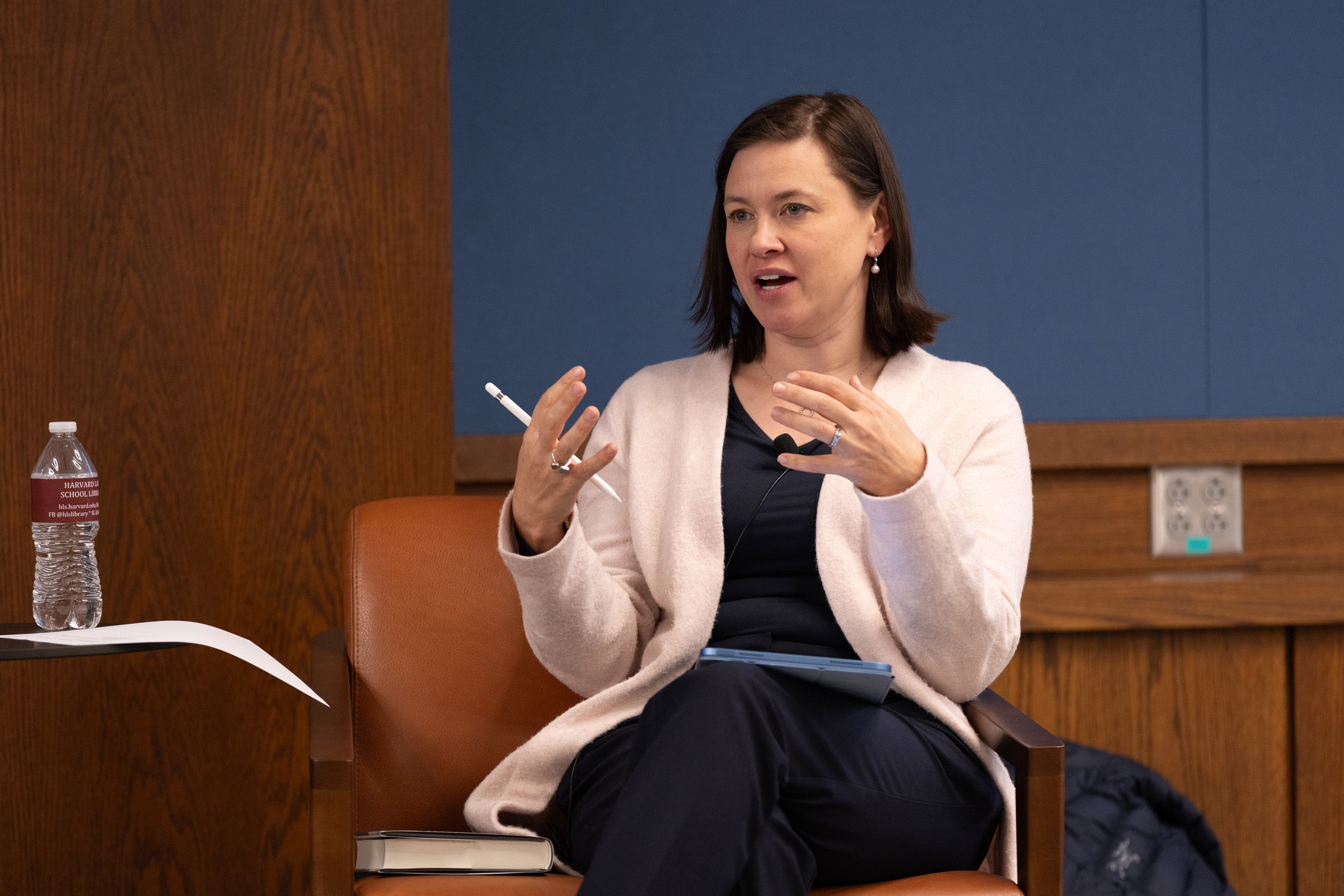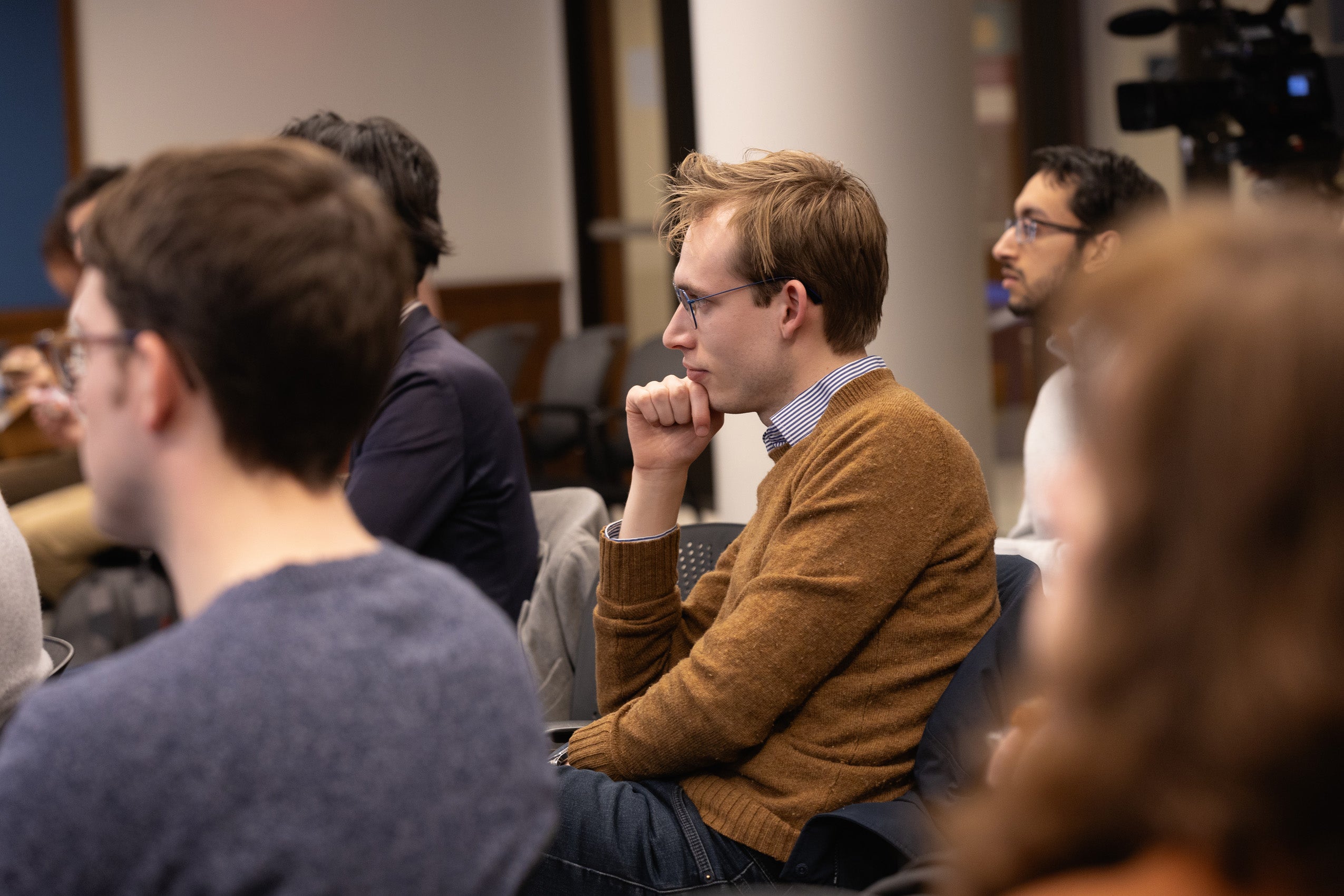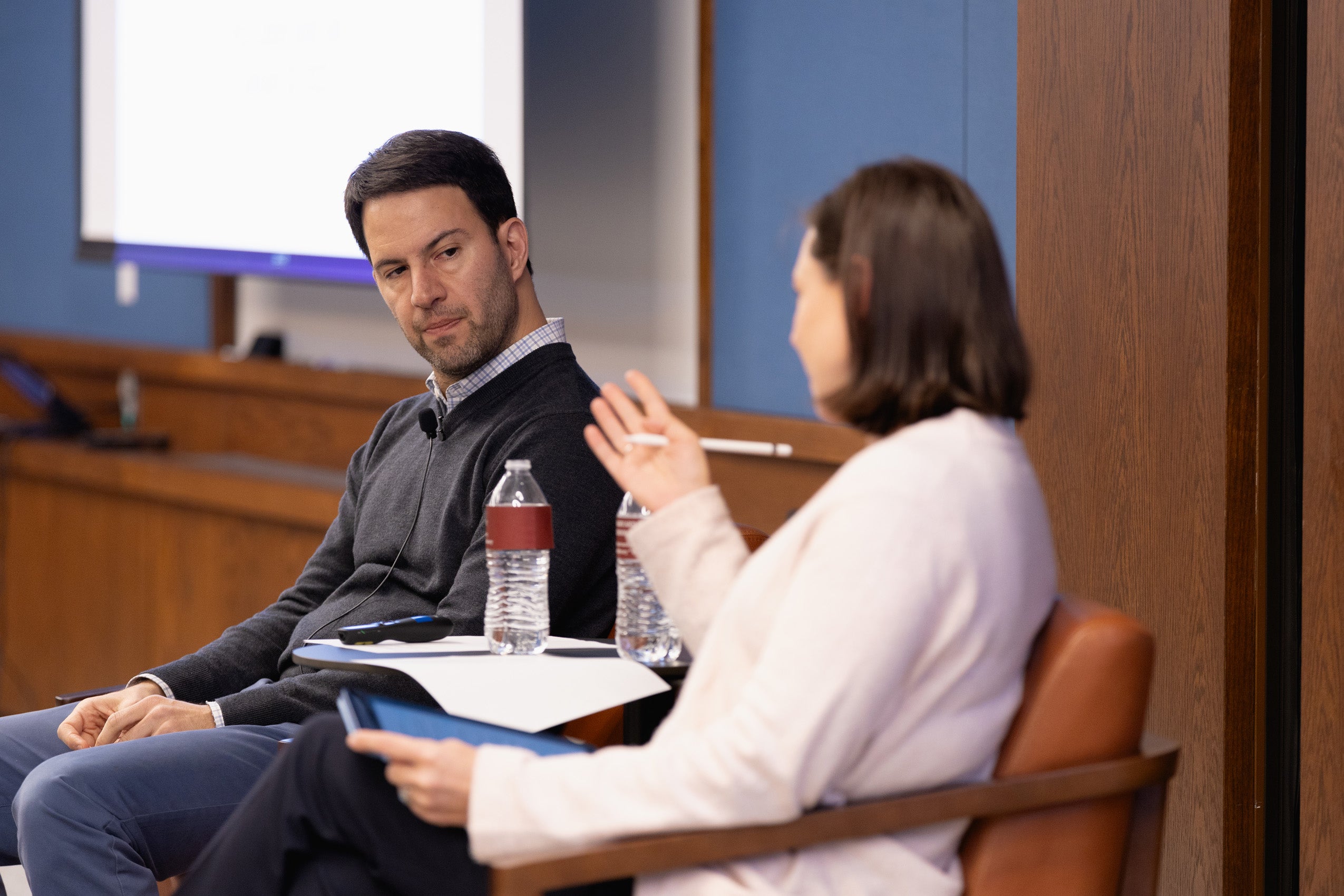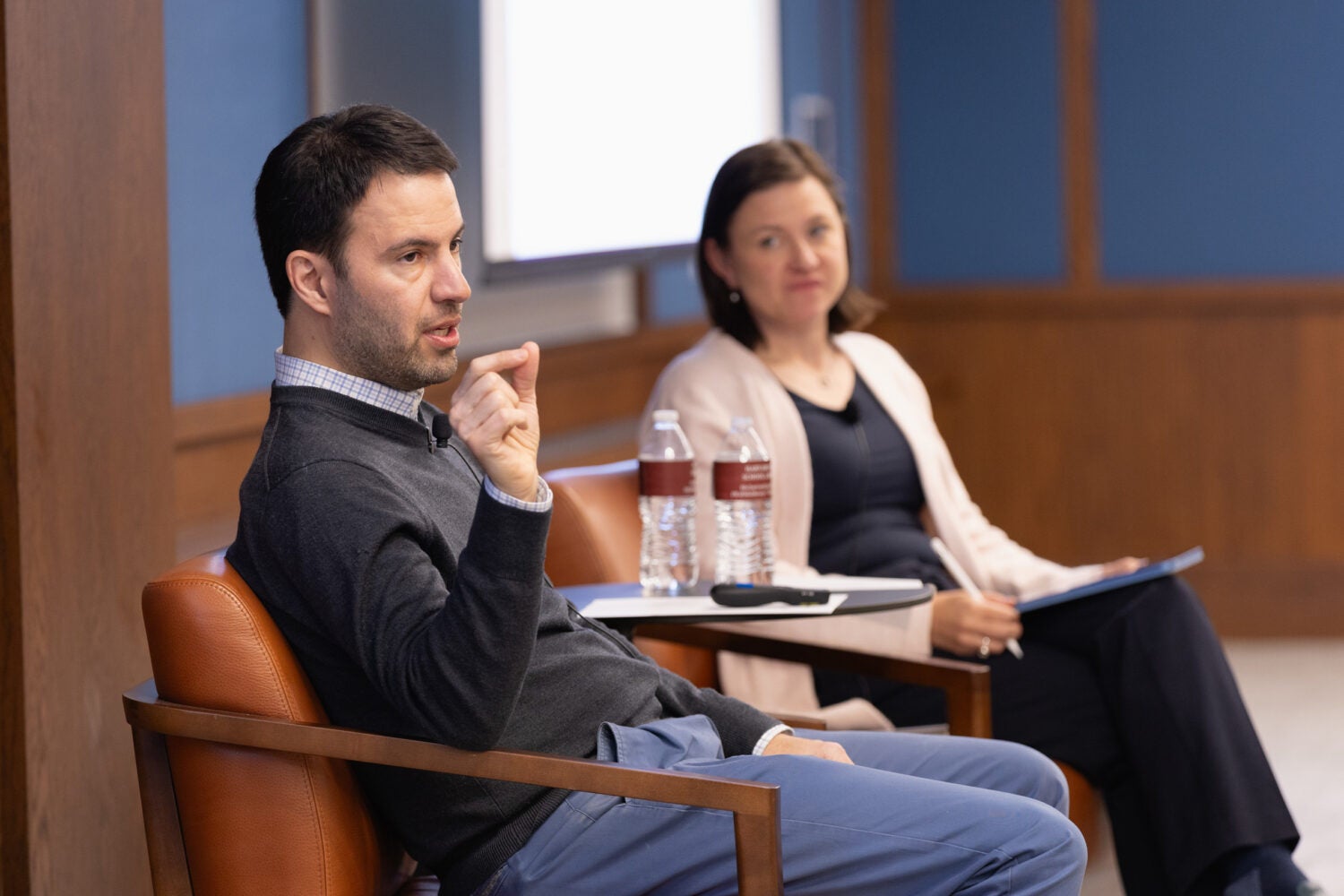If you worry that the wealthy control U.S. politics, you’re only partly right, Professor Nicholas Stephanopoulos told his Harvard Law School audience. Government policy doesn’t necessarily align with the preferences of the rich, he said. But it does track remarkably closely with the wishes of donors.
“The incredible evidence here … is that most voters are relatively moderate in their policy preferences,” he said. On the other hand, “Donors and spenders in the campaign finance world have extremely different views from the general public. They have sharply bi-modal policy preferences. Most donors are quite liberal or quite conservative, and there are very few moderate donors. And politicians’ voting records … turn out to be a perfect replica of the bi-modal distribution of donors.” Thus, it’s not simply a matter of the rich influencing the political agenda.
“Almost all donors are rich, but most rich people are not donors,” said Stephanopoulos, the law school’s Kirkland & Ellis professor of law, in a Jan. 29 discussion. “The views of rich non-donors don’t have much impact.”
That is among the issues that Stephanopoulos outlines in his new book “Aligning Election Law.” He discussed his findings at Langdell Library with Assistant Clinical Professor Ruth Greenwood, who directs the law school’s Election Law Clinic.
Alignment, Stephanopoulos explained, is the simple idea that the output of the government should correspond to what the people want the government to do. “This is a pretty intuitive value that lies at the core of many different conceptions of democracy,” he said. Alignment can be measured in political party affiliations, in representative stands that politicians take, and in the policies that are eventually enacted.
Yet there are significant areas in which the electorate’s wishes and the government’s output are greatly misaligned. One is the strong influence of donors and another involves gerrymandering — something that he and Greenwood have done substantial work to combat.
“Partisan gerrymandering lets you take the same set of voters, with the same partisan and ideological preferences. You draw one district configuration instead of another, and all of a sudden you’ve dramatically altered the partisan makeup of the legislature.” This, he suggested, has an outsized effect on policy, since “Gerrymandering takes you from way too liberal outcomes if the Democrats gerrymander to way too conservative outcomes if the Republicans gerrymander. That influence, that delta, is an order of magnitude larger than you get with voting policies, for example.
“So, I think there’s one takeaway for current electoral rules, it’s that money and politics and partisan gerrymandering matter more than any other electoral rules today,” he said. For that reason, he described the current state of alignment in American politics as “pretty poor.”
“I think there’s one takeaway for current electoral rules, it’s that money and politics and partisan gerrymandering matter more than any other electoral rules today.”
Nicholas Stephanopoulos
One brighter spot, he found, is the U.S. House of Representatives. “The U.S. House had been highly biased in a Republican and conservative direction through the 2010s,” he said. “Remarkably in the current cycle, Democratic gerrymanders basically offset Republican gerrymanders. So, in the aggregate, the U.S. House does not have, currently, a substantial partisan skew in either direction.” But here again, the bi-modal model, with legislators on both sides having more extreme views than the populace at large, still applied.
Playing devil’s advocate, Greenwood asked whether a drive for better alignment would even stand much of a chance in the current Supreme Court. “If I am trying to litigate to get more alignment, and I say that explicitly, I think of this Supreme Court as pursuing ends-motivated reasoning and not being interested in more progressive people being elected,” she said. “So I worry that they wouldn’t be interested in this.”
“I think the current Court would hate every bit of this,” Stephanopoulos concurred. Alignment theory, he said, involves a fundamental critique of the status quo and would be driven by data and empirical analysis. “So, I have precisely zero expectation that the current Supreme Court would be open to an alignment theory.”
He noted that both he and Greenwood had run into Supreme Court pushback when litigating gerrymandering cases. Chief Justice “John Roberts hated everything about this … But to me that’s fine because, first of all, quite a few state courts are more receptive to these kinds of structural democratic approaches.”



Further, he noted that some of the most aligning actions in U.S. political history — the Voting Rights Act, enfranchisement of women and minorities, campaign finance reform — happened largely because of Congress, not the courts. He mentioned an encouraging, omnibus electoral reform bill, the 2022 Electoral Count Reform Act, that came within two votes of Senate approval. “That bill would have done more aligning work in one stroke than every Supreme Court case put together.”
In many cases, he said, politicians simply get wrong information about public opinion. They “often misperceive what people want because they’re only hearing from the ideological fringes, the extremist loudmouth busybodies who approach members of the legislature. So more representative contact could help … Politicians often think that their constituents are much more left- or right-wing than they really are. One way to fix that might be for private actors to make available better data about public opinion.”
To that end, he and Greenwood have launched TrueViews (trueviews.org), which collects public opinion data on a variety of issues and filters them by area, allowing anyone to access how a particular state, city, or even school district stands on a particular topic. (It currently features data on gun control, environmental policies, criminal justice, and more.)
Stephanopoulos said they hope to partner with the nationally known polling site FiveThirtyEight Interactives to make their data more widely available. “The hope is that this tool will catch on and politicians will start to consult it to get accurate data about public opinion,” he said, “as opposed to relying on their inaccurate perceptions based on their unrepresentative contact with voters.”
Responding to an audience question, Stephanopoulos cited ballot initiatives as one tool for alignment, mentioning a successful Michigan anti-gerrymandering initiative. “The sitting politicians who benefited from gerrymandering in Michigan would never in a million years have agreed to this,” he said.
But he noted a flip side in which more generic ballot initiatives on wider topics — healthcare, welfare, gay rights — might get weaponized against minorities. “There,” he added, “I worry a bit that we don’t want alignment at all costs all the time.”
Want to stay up to date with Harvard Law Today? Sign up for our weekly newsletter.
